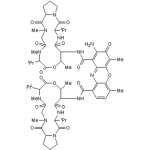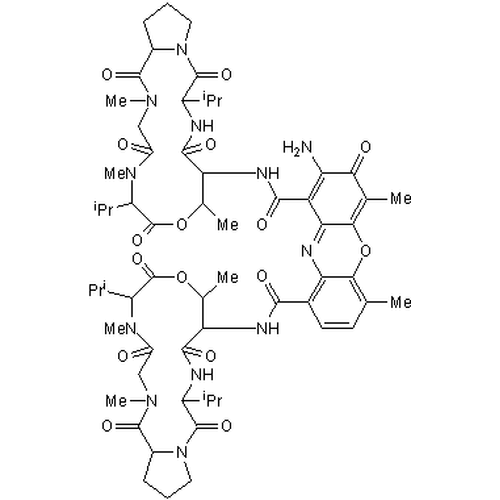| Product Name | Actinomycin D |
| Description |
Transcription inhibitor |
| Purity | >98% |
| CAS No. | 50-76-0 |
| Molecular Formula | C62H86N12O16 |
| Molecular Weight | 1255.43 |
| Field of Use | Not for use in humans. Not for use in diagnostics or therapeutics. For in vitro research use only. |
Properties
| Storage Temperature | -20ºC |
| Shipping Temperature | Shipped Ambient |
| Product Type | Inhibitor |
| Solubility | Soluble to 50 mM in DMSO |
| Source | Synthetic |
| Appearance | White Solid |
| SMILES | CC1C(C(=O)NC(C(=O)N2CCCC2C(=O)N(CC(=O)N(C(C(=O)O1)C(C)C)C)C)C(C)C)NC(=O)C3=C4C(=C(C=C3)C)OC5=C(C(=O)C(=C(C5=N4)C(=O)NC6C(OC(=O)C(N(C(=O)CN(C(=O)C7CCCN7C(=O)C(NC6=O)C(C)C)C)C)C(C)C)C)N)C |
| InChI | InChI=1S/C62H86N12O16/c1-27(2)42-59(84)73-23-17-19-36(73)57(82)69(13)25-38(75)71(15)48(29(5)6)61(86)88-33(11)44(55(80)65-42)67-53(78)3 |
| InChIKey | RJURFGZVJUQBHK-UHFFFAOYSA-N |
| Safety Phrases |
Classification: Very Toxic. May be fatal if inhaled, swallowed or absorbed through skin. Safety Phrases: S22 - Do not breathe dust S24/25 - Avoid contact with skin and eyes S36/37/39 - Wear suitable protective clothing, gloves and eye/face protection S45 - In case of accident or if you feel unwell, seek medical advice immediately (show the label where possible) Risk Phrases: R26/27/28 - Very Toxic by inhalation, in contact with skin and if swallowed R36/37/38 - Irritating to eyes, respiratory system and skin R40 - Limited evidence of a carcinogenic effect R62 - Possible risk of impaired fertility Hazard Phrases: H300 – Fatal if swallowed Precautionary Phrases: P264 –P301 + P310 |
| Cite This Product | Actinomycin D (StressMarq Biosciences, Canada, Cat # SIH-245) |
Biological Description
| Alternative Names | 2-Amino-N,N'-bis(6,13-diisopropyl-2,5,9-trimethyl-1,4,7,11,14-pentaoxohexadecahydro-1H-pyrrolo[2,1-i][1,4,7,10,13]oxatetraazacyclohexadecin-10-yl)-4,6-dimethyl-3-oxo-3H-phenoxazine-1,9-dicarboxamide |
| Research Areas | Apoptosis, Cancer |
| PubChem ID | 2019 |
| Scientific Background | Actinomycin D is a polypeptide antibiotic that inhibits transcription by binding to DNA and preventing RNA polymerase elongation. In neuroscience, it is used to study gene expression regulation, transcriptional responses to stress, and the role of RNA synthesis in neuronal survival and plasticity. |
| References |
1. Sobell H. (1985) Proc Natl Acad Sci USA. 82(16): 5328-31. 2. Turan T., et al. (2006) Int J Gynecol Cancer. 16(3): 1432-1438. |



Reviews
There are no reviews yet.